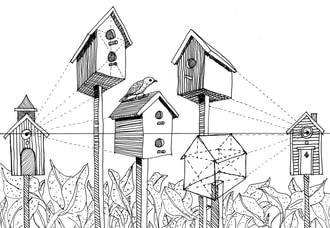Exam Assignment:
Design a realistic/fantasy treehouse using two-point perspective.
Goals: Apply understanding of 2-point perspective techniques to create the illusion of 3-d form and deep space, work with a detailed illustrative style, learn to draw trees realistically, explore basic architectural ideas.
Project Steps:
1. Draw a realistic tree on your drawing paper.
2. Decide whether you would like your horizon line should be high on the paper (you’ll be looking down at your treehouse) or low (you’ll be looking up at the bottom of your treehouse) or in the middle (eye level). Tape your drawing paper on top of a longer sheet of paper, positioning it where your want your horizon line, in order to get your vanishing points farther away from your drawing, to avoid distortion.
3. Use the guidelines given to create a main structure for your treehouse using correct 2-point perspective technique. Remember that in 2-point perspective, you are looking at it from an angle, and you start with a line, not a box. Add on to this structure, or create other separate structures, to form the basic composition of your drawing. Be very imaginative with the type of structure.
4. Draw very lightly as you lay out your ideas! This will make your corrections less frustrating.
5. You should challenge yourself with a high school level of complexity. Include challenges such as add-ons, openings, multi-levels, or directional changes.
6. You may use ONLY the same two vanishing points for the whole project. They must be on the horizon line.
7. Draw the background: Deliberately use other perspective techniques in this drawing: you must have unattached objects overlapped with other objects, and the objects in front must be MUCH bigger than those in the background (size perspective). Make sure, as you create the landscape/context for your treehouse, that you use placement perspective and atmospheric perspective correctly.
8. Add surface texture and final details (for example, tree bark, trees and other objects in the background, etc).
9. Add surface details, especially to closer objects.
As part of your exam packet you must show several sketches and preparatory drawings where you have worked out details of your project.
Vocabulary
Horizon line: where the sky appears to meet the ground.
Linear perspective: a mathematical system for creating the illusion of space and distance on a flat surface.
Monochromatic: using one color and its tints and shades.
Two-point perspective: a way to show three-dimensional objects on a two-dimensional surface, using two vanishing points. The viewer is seeing the objects from an angle.
Orthogonal lines: straight diagonal lines drawn to connect points around the edges of a picture to the vanishing point. They represent parallel lines receding into the distance and help draw the viewer’s eye into the depth of the picture.
Overlapping perspective: enhancing the illusion of depth in an artwork by purposefully placing some objects in front of others, making them appear closer.
Placement perspective: enhancing the illusion of depth in an artwork by placing nearer objects lower in the picture, and farther ones higher.
Size perspective: enhancing the illusion of depth in an artwork by making objects closer appear larger in the picture.
Atmospheric perspective: enhancing the illusion of depth in an artwork by making closer objects sharper and clearer, and farther objects less distinct.
Vanishing point: where all orthogonal lines that run towards the horizon line appear to come together.
Project guidelines:
Horizon line and vanishing points correct. 2-pt perspective is used correctly overall.
Your understanding of overlapping, size, and placement perspective is clear.
Your tree is drawn realistically. Your forms are complex, varied, and detailed. Your understanding of perspective techniques is evident. Your craftsmanship on all elements is outstanding.
Craftsmanship: Your drawing is done with neatness and care. You have challenged yourself with detail and complexity. There are no areas that are unfinished, sloppy, or detract from the design.
Imagination/creativity: You have stepped outside your safety zone and tried new things. Your treehouse is not copied, but shows imagination. You have fully developed your ideas.
Effort/attitude: You challenged yourself. You worked through each stage with patience and commitment. You came to class prepared, were on task every class period and used each hour fully. You were responsible with art supplies. Your behavior during the project made a positive contribution to the class, and you were a help and inspiration to other students



